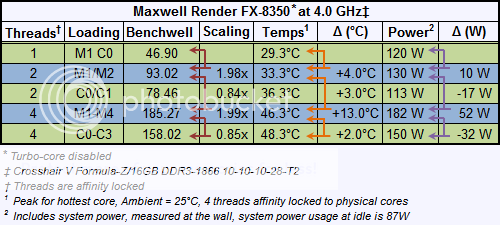thanks again for all the testing, the result with super pi is quite interesting, it seems like the sharing of resources doesn't really have a big effect on it, I expected it to be a lot more significant when I asked for,
to see how it works with HT I tested here with 2m on a i3, it was around 31s 2c, 40s 1c/2t and 50s 1c/1t (2 super pi 2m at the same time)
There really is no question, overall comparing AMD's current implementation of CMT to that of Intel's SMT (hyperthreading), the CMT approach is superior in terms of performance scaling.
Where it falls flat is in the marketing claims of "cores", Intel rightly avoids setting consumer expectations to expect their 4C/8T processors as being 8C processors (so the glass is always half-full from the consumer perspective - you bought 4 cores but you get a little more than that) whereas AMD sets themselves up for the consumer to have expectations that simply can never be met because at best their 8-core processor is going to perform like a 6-7 core processor (so the glass is always half-empty from the consumer perspective - you bought 8 cores but you always get a bit less than that).
That is what I call dumb marketing because you know in advance that you are not going to fool anyone for very long, eventually everyone will be on to you and they'll be irritated for having been deceived. Not that AMD is lying, of course there are technically 8 cores there, but expectations are set on the basis of technicalities that are then not achieved, and customer perception becomes one of buyer's remorse at that point. It takes dumb marketing to invite that sort of customer perception, especially when they would have known well in advance that it was going to be an issue.
Look at how ARM is handling it, they could call a 4+4 big.LITTLE chip an "8-cores of power! it goes to 11!" or they could rightly set customer's expectations such that the customer knows in advance the product has 4 big cores and 4 little cores. Yes there are 8 cores in there but no one is trying to pull the wool over anyones eyes, it is accepted that 4 of those cores are going to be lesser performing siblings compared to the other 4 cores.
And that is what the FX-8350, a 4x4 x86 big.LITTLE style microarchitecture of sorts. If you power up all four modules and use the chip as a quad-core you get really good performance scaling and as a quad-core the overall performance is not bad. If you go power-miser style and power up just two modules, power-gate the other two, then your four threads still get decent performance but at a reduced power footprint.
The other thing that unfortunately undermines the credibility of AMD's CMT approach is that the overall performance per core is lower than that of their previous cores (as well as the competition) which is not the fault of CMT itself per se. AMD really made some unfortunate design choices with bulldozer/piledriver versus what they had going for them with thuban at least.
Not only is the performance lacking, but the core size itself is also rather large. In other words they win on exactly no fronts with their current implementation - die size comes out too large, performance comes out too low, and power comes out too high. It is the perfect design if your goal was to bankrupt the company

And it didn't have to be this way, that is the real kicker.






